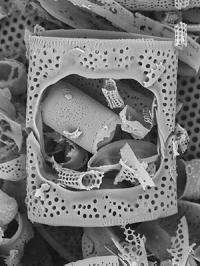Arctic climate under greenhouse conditions in the Late Cretaceous

New evidence for ice-free summers with intermittent winter sea ice in the Arctic Ocean during the Late Cretaceous - a period of greenhouse conditions - gives a glimpse of how the Arctic is likely to respond to future global warming.
Records of past environmental change in the Arctic should help predict its future behaviour. The Late Cretaceous, the period between 100 and 65 million years ago leading up to the extinction of the dinosaurs, is crucial in this regard because levels of carbon dioxide (CO2) were high, driving greenhouse conditions. But scientists have disagreed about the climate at this time, with some arguing for low Arctic late Cretaceous winter temperatures (when sunlight is absent during the Polar night) as against more recent suggestions of a somewhat milder 15°C mean annual temperature.
Writing in Nature, Dr Andrew Davies and Professor Alan Kemp of the University of Southampton's School of Ocean and Earth Science based at the National Oceanography Centre, Southampton, along with Dr Jennifer Pike of Cardiff University take this debate a step forward by presenting the first seasonally resolved Cretaceous sedimentary record from the Alpha Ridge of the Arctic Ocean.
The scientists analysed the remains of diatoms - tiny free-floating plant-like organisms - preserved in late Cretaceous marine sediments. In modern oceans, diatoms play a dominant role in the 'biological carbon pump' by which carbon dioxide is drawn down from the atmosphere through photosynthesis and a proportion of it exported to the deep ocean. Unfortunately, the role of diatoms in the Cretaceous oceans has until now been unclear, in part because they are often poorly preserved in sediments.
But the researchers struck lucky. "With remarkable serendipity," they explain, " successive US and Canadian expeditions that occupied floating ice islands above the Alpha Ridge of the Arctic Ocean, recovered cores containing shallow buried upper Cretaceous diatom ooze with superbly preserved diatoms." This has allowed them to conduct a detailed study of the diatom fossils using sophisticated electron microscopy techniques. In the modern ocean, scientists use floating sediment traps to collect and study settling material. These electron microscope techniques that have been pioneered by Professor Kemp's group at Southampton have unlocked a 'palaeo-sediment trap' to reveal information about Late Cretaceous environmental conditions.
They find that the most informative sediment core samples display a regular alternation of microscopically thin layers composed of two distinctly different diatom assemblages, reflecting seasonal changes. Their analysis clearly demonstrates that seasonal blooming of diatoms was not related to the upwelling of nutrients, as has been previously suggested. Rather, production occurred within a stratified water column, indicative of ice-free summers. These summer blooms comprised specially adapted species resembling those of the modern North Pacific Subtropical Gyre, or preserved in relatively recent organically rich Mediterranean sediments called 'sapropels'.
The sheer number of diatoms found in the Late Cretaceous sediment cores indicates exceptional abundances equalling modern values for the most productive areas of the Southern Ocean. "This Cretaceous production, dominated by diatoms adapted to stratified conditions of the polar summer may also be a pointer to future trends in the modern ocean," say the researchers: "With increasing CO2 levels and global warming giving rise to increased ocean stratification, this style of (marine biological) production may become of increasing importance."
However, thin accumulations of earthborn sediment within the diatom ooze are consistent with the presence of intermittent sea ice in the winter, a finding that supports "a wide body of evidence for low Arctic late Cretaceous winter temperatures rather than recent suggestions of a 15C mean annual temperature at this time." The size distribution of clay and sand grains in the sediment points to the formation of sea ice in shallow coastal seas during autumn storms but suggests the absence of larger drop-stones suggests that the winters, although cold, were not cold enough to support thick glacial ice or large areas of anchored ice.
Commenting on the findings, Professor Kemp said: "Although seasonally-resolved records are rarely preserved, our research shows that they can provide a unique window into past Earth system behaviour on timescales immediately comparable and relevant to those of modern concern."
More information: Davies, A., Kemp, A. S. & Pike, J. Late Cretaceous seasonal ocean variability from the Arctic. Nature 460, 254-258 (9 July 2009). www.nature.com/nature/journal/ … ull/nature08141.html
Source: National Oceanography Centre, Southampton

















